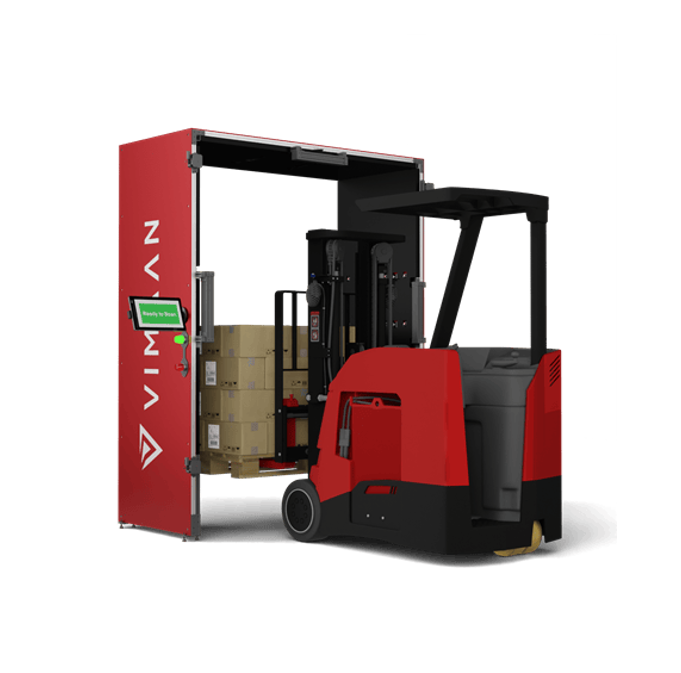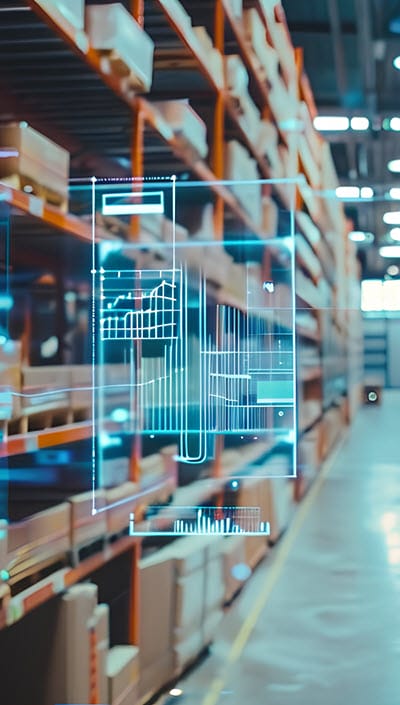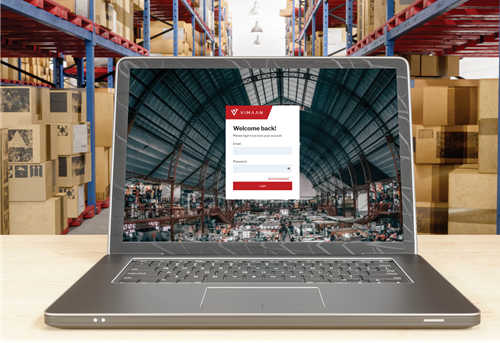Warehouse Package Scanning
Fast scanning and validation of incoming and outgoing packages with ParcelSCAN
Your browser is out of date, for the best web viewing experience visit Browse Happy to upgrade your browser today.
The AI-powered warehouse has become a transformative force in the logistics and supply chain industry. With the integration of artificial intelligence (AI), machine learning, and computer vision, warehouses are evolving into smart, efficient, and highly automated environments that can handle the complexities of modern logistics. One of the key areas where AI is making a significant impact is cycle counting, a crucial process for inventory management and improving overall warehouse efficiency.

An AI warehouse leverages artificial intelligence and related technologies to automate, optimize, and enhance various operations. These technologies include machine learning algorithms, computer vision, robotics, and the Internet of Things (IoT), all working together to create a seamless and efficient workflow. The primary goal of an AI warehouse is to lower human intervention in routine tasks, minimize errors, reduce inventory shrinkage and improve overall operational efficiency.
In an AI warehouse, traditional manual processes are replaced or augmented with automated systems that can perform tasks such as warehouse receiving, sorting, picking, packing, and cycle counting. These systems are not only faster but also more accurate, reducing the likelihood of errors that can lead to costly disruptions in the supply chain.
One of the most critical areas where AI warehouses excel is inventory management. Traditional warehouses rely heavily on manual processes for tracking and managing inventory, which can be time-consuming and prone to errors. This is especially true in the validation and documentation of our incoming and outgoing goods. In contrast, AI-powered systems like PalletSCAN and ParcelSCAN deliver automated scanning and validation of inventory entering and leaving the warehouse. These AI powered systems scan, inspect, dimension and validate goods faster and more reliably than manual processes.


AI warehouses significantly enhance order fulfillment processes by automating tasks such as picking, packing, and shipping. AI-powered systems can quickly and accurately locate items within the warehouse, reducing the time it takes to fulfill orders. By leveraging machine learning enabled computer vision systems like PackVIEW, warehouse scan also validate orders as they are being assembled to ensure shipments are accurate and complete.
Moreover, AI can be used to analyze order patterns and predict future demand, allowing warehouses to prepare for peak periods and ensure that the right products are available when needed. This results in faster order processing, improved customer satisfaction, and a more efficient supply chain.
AI warehouses reduce the reliance on manual labor for routine tasks, allowing human workers to focus on more complex and value-added activities. For example, instead of spending hours manually counting inventory, workers can leverage automated systems, manage exceptions, and ensure that the warehouse operates smoothly. An excellent example of this is the use of StorTRACK for automated cycle counting. This machine-learning enabled system scans 50 items as fast as it scans one and can capture an entire 300’ long x 30’ high warehouse aisle in about a half hour.
Artificial intelligence can also assist in workforce management by analyzing data on employee performance, workload, and shift patterns. This enables warehouse managers to optimize labor allocation, ensuring that the right number of workers are assigned to each task based on real-time demand.
In an AI warehouse, equipment and machinery are equipped with IoT sensors that continuously monitor their performance. AI algorithms analyze this data to predict when maintenance is needed, reducing the risk of unexpected breakdowns and costly downtime. Predictive maintenance ensures that equipment is always in optimal condition, contributing to the overall efficiency of the AI warehouse.

Edge computing plays a critical role in enhancing the capabilities of AI in warehouse operations by processing data closer to the source, reducing latency, and improving real-time decision-making. In an AI warehouse, edge devices such as sensors, cameras, and robots collect vast amounts of data from various sources, including inventory levels, environmental conditions, and equipment performance. Instead of sending all this data to a central cloud for processing, edge computing enables these devices to analyze and act on the data locally.
This localized processing allows for immediate responses to critical events, such as identifying a misplaced item or adjusting a robotic arm’s movement to avoid a collision, without the delays that can occur with cloud-based processing. Additionally, edge computing helps in managing the bandwidth and security challenges associated with transferring large volumes of data to the cloud. By integrating edge computing with AI, warehouses can achieve more efficient and resilient operations, optimizing processes like real-time inventory management, predictive maintenance, and automated quality control, all while reducing the dependency on centralized data centers.
AI warehouses automate some of the most fractionally labor-intensive and time-consuming activities. This often includes the deployment of AI and machine learning powered computer vision.
For most warehouses, the process of inspecting, scanning and validating incoming and outgoing goods is still highly manual and prone to error. These were driving forces is the development of the PalletSCAN and ParcelSCAN family of products. Using Vimaan advanced computer vision technology, AI warehouses can now automate routine processes including:


The more successful AI warehouses automate the cycle counting process using StorTRACK to capture and report on inventory levels, scan inventory in high bays, identify WMS discrepancies and even misplaced items. StorTRACK performs cycle counts quickly and accurately, often without the need to interrupt warehouse operations. Using Vimaan’s advanced warehouse compute vision, StorTRACK captures images of all the stored inventory including pallets and cases. AI algorithms then analyze these images to count items, detect discrepancies, and provide up to date data to the warehouse WMS.
This automated approach not only saves time but also improves the accuracy of cycle counts. Human errors, such as miscounts or missed items, are eliminated, ensuring that inventory records are always up to date. Additionally, automated cycle counting can be performed more frequently, allowing warehouses to maintain a higher level of inventory accuracy and reduce the need for costly full physical counts.
StorTRACK’s computer vision technology is capable of recognizing items, barcodes, and labels on shelves, even in challenging environments such as high racks or dimly lit areas. The system can also detect changes in inventory, such as when an item is added or removed, and update the warehouse management system (WMS) accordingly. This level of accuracy ensures that warehouses can maintain precise inventory records, reducing the risk of stockouts, overstocking, and other inventory-related issues.
Moreover, Vimaan’s computer vision technology is highly scalable, making it suitable for AI warehouses of all sizes. Whether a small warehouse with limited inventory or a large distribution center with thousands of SKUs, StorTRACK can be tailored to meet the specific needs of the operation.
Vimaan’s computer vision technology is designed to be scalable and flexible, making it suitable for a wide range of warehouse environments. Whether a warehouse is small or large, Vimaan’s system can be easily integrated into existing operations and scaled as needed. This flexibility allows AI warehouses to adapt to changing business needs and maintain optimal efficiency.
Another key advantage of computer vision technology in an AI warehouse AIis the ability to provide up to date data and analytics. AI Warehouses can access inventory information at any time using the Vimaan ViewDECK web application, allowing for better decision-making and more accurate demand forecasting. Included in the application is an image repository of all the scans conducted by Vimaan solutions, providing warehouse with visual evidence of inventory conditions and levels. ViewDECK also generates detailed reports on inventory trends, discrepancies, and other key metrics, providing valuable insights for continuous improvement.

As AI technology continues to advance, the potential for AI warehouses to revolutionize the logistics and supply chain industry is immense. In the future, we can expect to see even greater levels of automation, with AI systems capable of managing entire warehouse operations with minimal human intervention. This will lead to further improvements in efficiency, accuracy, and cost savings, as well as enhanced customer satisfaction.
Vimaan’s computer vision technology is at the forefront of this revolution, providing AI warehouses with the tools they need to achieve unprecedented levels of accuracy and efficiency in inventory management. As more warehouses adopt AI-powered solutions the industry will continue to evolve, setting new standards for what is possible in modern logistics. With Vimaan’s cutting-edge computer vision technology, warehouses can automate cycle counting, improve inventory accuracy, and reduce operational costs, setting the stage for a new era of smart, efficient, and highly automated warehouse operations.
Make Your Facility an AI Warehouse – Contact the AI Team Today

This all-inclusive automation resource kit includes:
– Cycle Count Automation Demo Videos
– Real-world case study results
– Comprehensive automation guide
– Technology benchmark videos
– Product data sheets and specifications
– Sarbanes-Oxley compliancy technical note
– And more!
Fast scanning and validation of incoming and outgoing packages with ParcelSCAN
Warehouses are capturing all 4 sides of pallets faster than ever before with PalletSCAN 360.
Distributors reliably scan all outgoing cases in seconds ensuring customer orders are correct before shipping